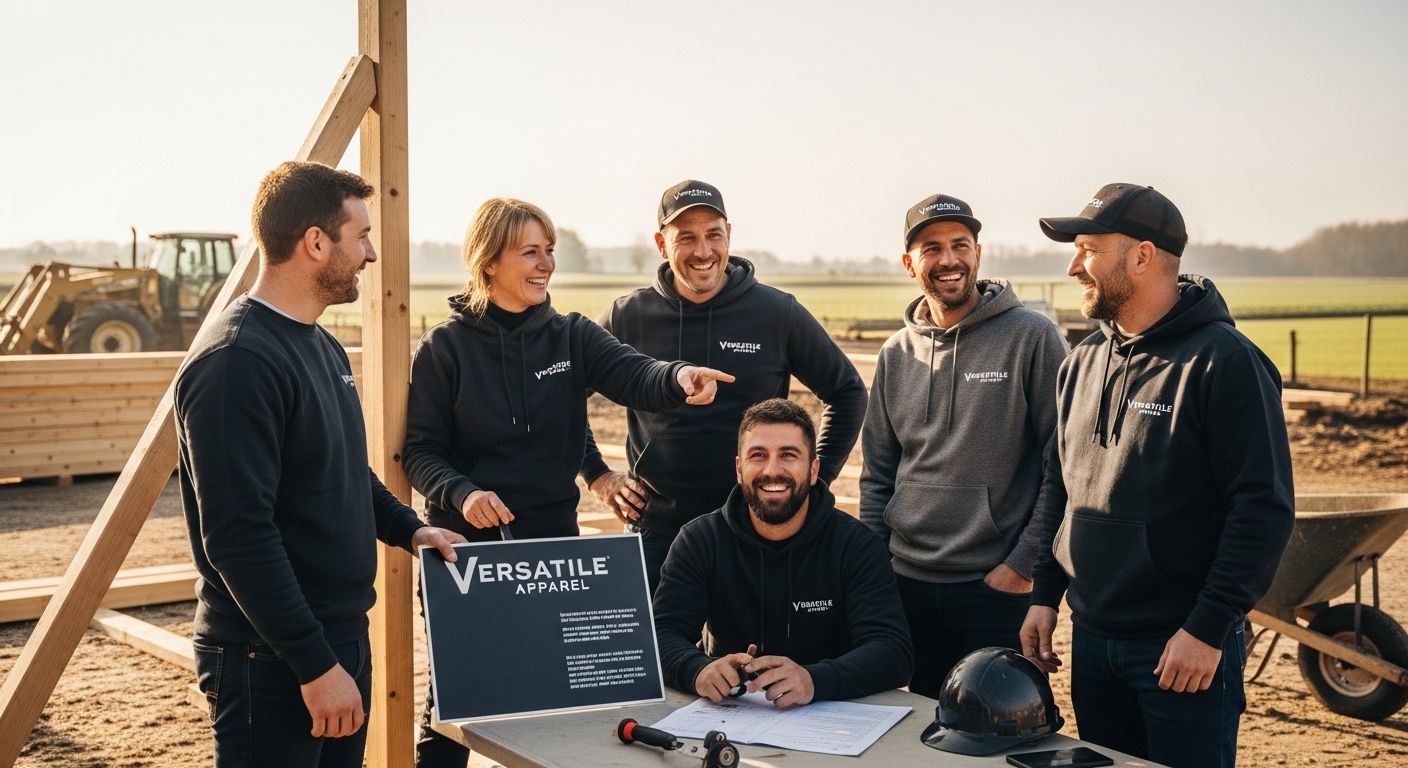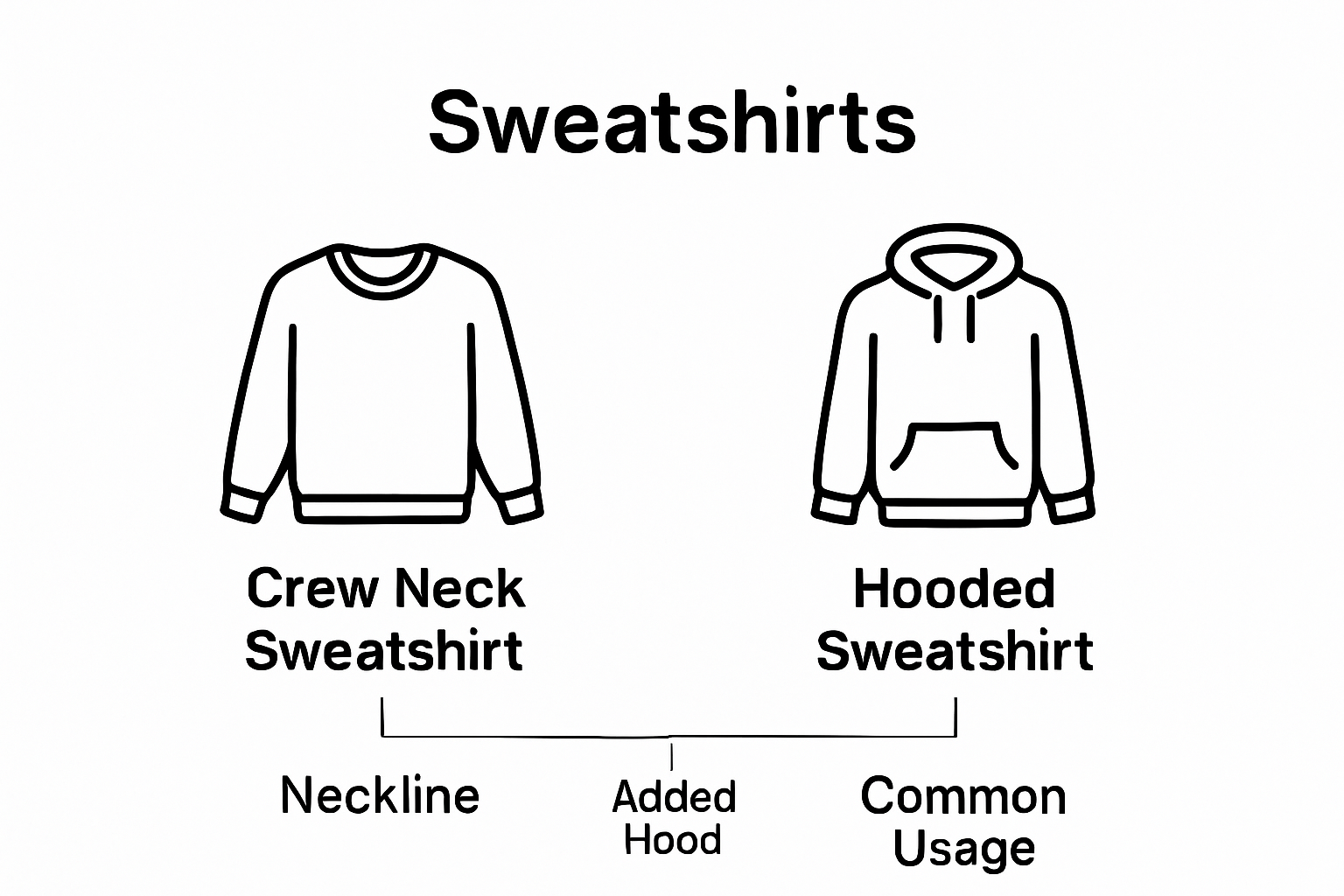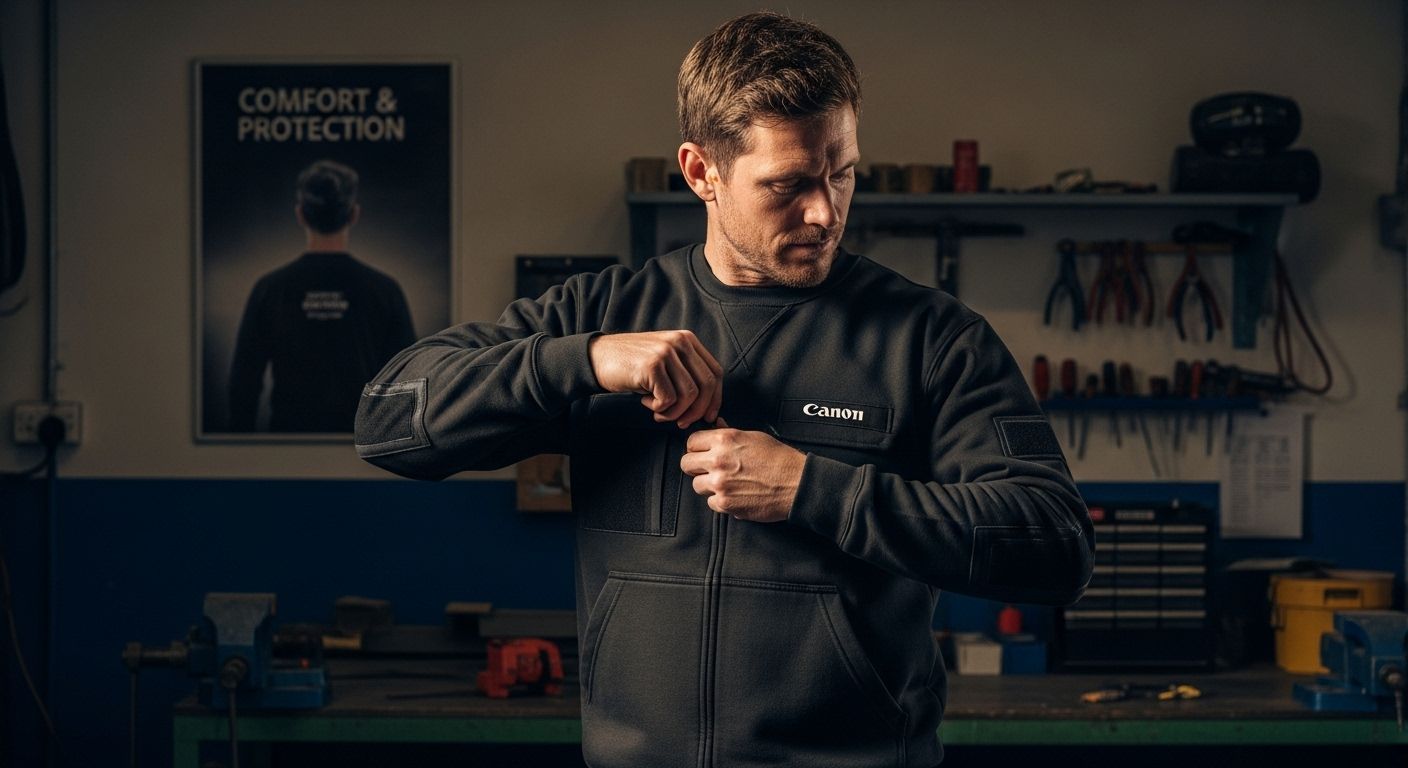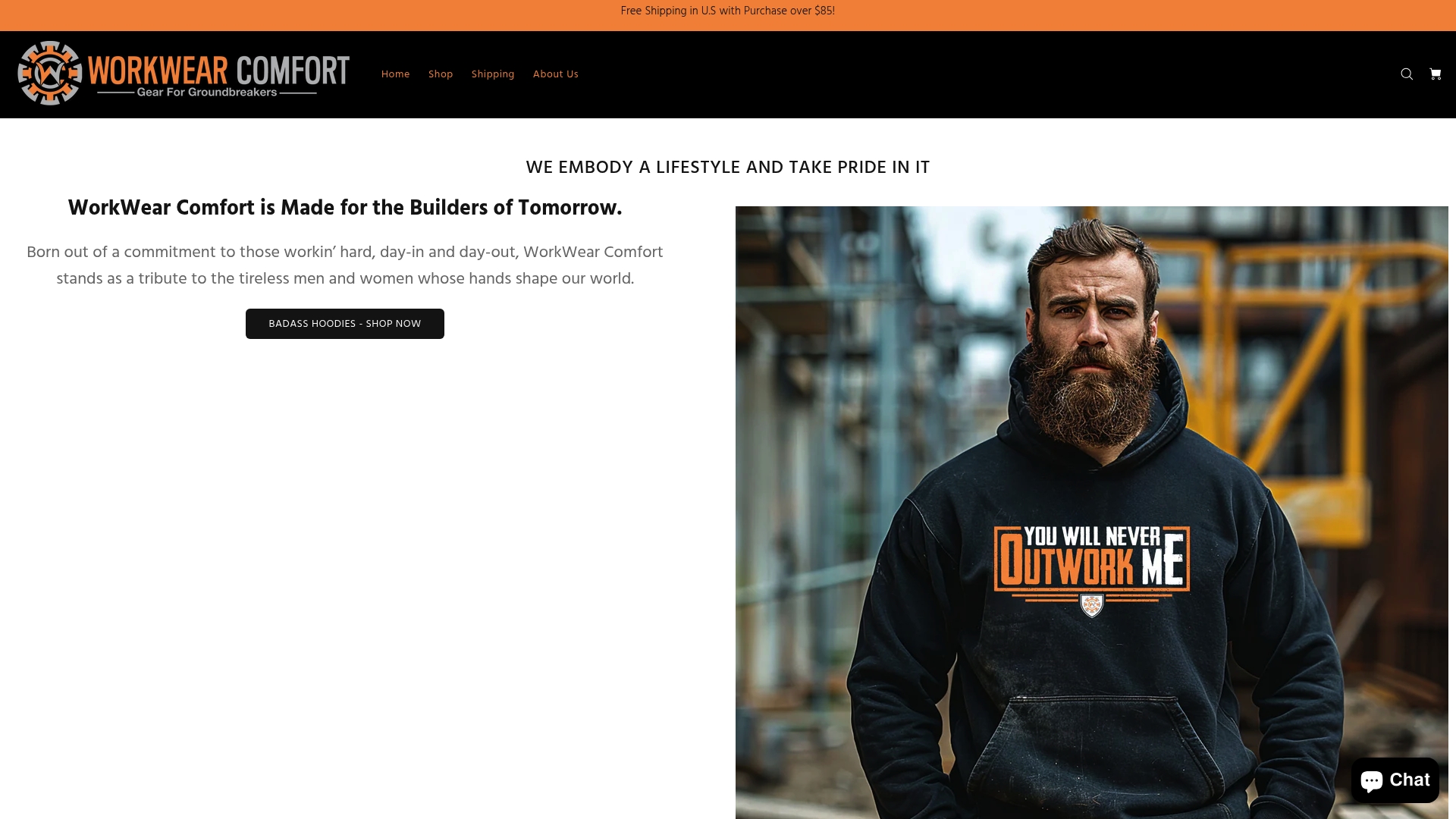
Sweatshirts are everywhere on job sites, from chilly farms to busy construction crews. Most people think of them as basic comfort wear, but that misses the big picture. Studies show that proper work sweatshirts can reduce muscle fatigue and protect against cold stress, directly supporting worker health and productivity. Finding out what truly sets these garments apart may change how you dress for work forever.
Table of Contents
- What Is A Sweatshirt And Its Key Features
- Why Sweatshirts Are Essential For Blue Collar Work
- How Sweatshirts Provide Comfort And Protection In Various Environments
- Exploring Materials And Designs Of Sweatshirts For Specific Needs
- The Role Of Sweatshirts In Lifestyle And Rugged Aesthetics
Quick Summary
| Takeaway | Explanation |
|---|---|
| Sweatshirts offer excellent thermal regulation. | Their design traps body heat while wicking moisture away for comfort. |
| Durability is key for work sweatshirts. | Thick fabrics resist wear and tear, ensuring long-lasting use in tough environments. |
| Fit matters for mobility and comfort. | A relaxed fit allows for unrestricted movement, which is essential for physical jobs. |
| Choose specialized designs for your environment. | Different professions require specific features like reinforced patches and moisture management. |
| Cultural significance enhances their appeal. | Sweatshirts symbolize resilience and pride among blue-collar workers, making them more than just clothing. |
What is a Sweatshirt and its Key Features
A sweatshirt is a versatile piece of apparel designed for comfort, warmth, and functionality. Originally developed as athletic wear, these garments have evolved into essential clothing for workers, athletes, and casual wearers alike. Crafted from soft, heavyweight cotton or cotton blend fabrics, sweatshirts offer exceptional insulation and breathability.
Design and Construction
Sweatshirts are characterized by their unique construction featuring a soft interior fleece lining that traps body heat while allowing moisture to wick away. Unlike standard shirts, sweatshirts typically feature a relaxed fit with ribbed cuffs and waistband to prevent cold air from entering. Learn more about work-ready apparel design to understand how these garments are engineered for maximum performance.
Key design elements include:

- Crew neck or hooded variations
- Heavyweight cotton or fleece materials
- Reinforced stitching for durability
- Elastic cuffs and waistband for better insulation
Functional Performance
Beyond basic clothing, sweatshirts serve multiple practical purposes for blue-collar workers and outdoor professionals. The thick fabric provides protection against mild wind and temperature variations, making them ideal for layering in challenging work environments. Their loose fit allows unrestricted movement, crucial for physical labor and active jobs.
According to textile research from Marshall University, sweatshirts represent more than just clothing they are functional gear designed to support worker comfort and productivity. The material’s ability to regulate body temperature while providing robust protection makes them an indispensable wardrobe staple for tradespeople and outdoor workers.
Whether you’re working construction, managing a farm, or tackling weekend projects, a well-designed sweatshirt offers the perfect blend of comfort, durability, and professional functionality.
Why Sweatshirts are Essential for Blue Collar Work
Blue collar work demands clothing that can withstand harsh environments, provide protection, and support physical performance. Sweatshirts have emerged as a critical piece of workwear that meets these demanding requirements, offering far more than simple comfort.
Protection and Performance
For workers in construction, agriculture, and trades, a sweatshirt is not just clothing but protective gear. The thick fabric acts as a barrier against environmental challenges like wind, mild cold, and dust. Its ability to regulate body temperature helps workers maintain consistent comfort during long, physically demanding shifts. Check out our guide on selecting the perfect work hoodie to understand how to choose the right protective layer.
Key protective features include:
- Robust fabric that resists wear and tear
- Insulation against temperature fluctuations
- Moisture wicking capabilities
- Flexible design allowing full range of motion
Workplace Health and Ergonomics
According to research from the National Center for Biotechnology Information, appropriate work attire plays a crucial role in managing physical strain and potential health risks. Sweatshirts contribute to worker comfort by providing crucial support during physically intensive tasks. The loose yet structured fit helps reduce muscle fatigue and supports better overall workplace ergonomics.
Blue collar professionals face unique physical challenges that require clothing designed for performance. A well constructed sweatshirt does more than cover the body it becomes an essential tool that supports worker productivity, safety, and comfort across diverse work environments.

How Sweatshirts Provide Comfort and Protection in Various Environments
Sweatshirts represent more than simple clothing they are sophisticated protective gear engineered to support workers across diverse and challenging work environments. Their advanced material design allows them to adapt to changing conditions while maintaining optimal worker comfort and performance.
Thermal Regulation and Moisture Management
The core function of a high quality sweatshirt is its ability to manage body temperature and moisture effectively. By utilizing specialized fabric technologies, sweatshirts create a microclimate that keeps workers comfortable during physically demanding tasks. Explore our comprehensive workwear protection guide to understand how advanced textiles make this possible.
Key thermal management features include:
- Strategic insulation that traps body heat
- Breathable fabric that prevents overheating
- Quick moisture wicking capabilities
- Lightweight design for unrestricted movement
Environmental Adaptability
According to research from the National Institutes of Health, textile choices significantly impact worker comfort. Sweatshirts made from advanced cotton and polyester blends provide exceptional protection against environmental challenges. Whether facing cold construction sites, windy agricultural fields, or humid workshop environments, these garments maintain consistent thermal comfort.
The versatility of sweatshirts extends beyond temperature control. Their robust design offers protection against minor abrasions, dust, and light wind while maintaining flexibility crucial for physical labor. Blue collar workers rely on these garments as a critical layer of defense against workplace environmental stressors.
Exploring Materials and Designs of Sweatshirts for Specific Needs
Sweatshirts are not a one size fits all garment. Different work environments and professional demands require specialized materials and design features that go beyond basic clothing functionality. Understanding these nuanced variations helps workers select the most appropriate protective gear for their specific job requirements.
Material Science and Performance
Modern sweatshirt design leverages advanced textile technologies to create garments that perform under challenging conditions. Cotton blends, synthetic fibers, and specialized weaves combine to offer durability, flexibility, and protection. Discover expert tips for selecting the perfect work sweatshirt to understand how material selection impacts performance.
Key material performance characteristics include:
- Resistance to abrasion and tear
- Chemical and stain repellent properties
- UV protection capabilities
- Enhanced moisture management
Design Features for Specialized Environments
According to research from TeachEngineering, innovative textile design goes beyond traditional fabric construction. Sweatshirts for blue collar workers incorporate features like reinforced elbow patches, multiple utility pockets, adjustable hoods, and strategic ventilation zones. These design elements transform sweatshirts from simple clothing into specialized work equipment.
Different professional sectors demand unique design approaches. Construction workers might prioritize rugged materials with high abrasion resistance, while agricultural workers need lightweight fabrics with superior moisture wicking. The versatility of modern sweatshirt design ensures that every worker can find a garment tailored to their specific environmental and functional needs.
To help you compare how different material choices and sweatshirt designs address distinct work demands, the table below summarizes the most important features and their impact on real-world performance.
| Feature / Material | Benefit | Relevant Work Environments |
|---|---|---|
| Heavyweight cotton/fleece | Superior insulation & breathability | Construction, farming, outdoor projects |
| Abrasion-resistant fabrics | Enhanced durability | Construction, trade, high-wear settings |
| Moisture-wicking blends | Better sweat management | Workshops, humid sites, active labor |
| Reinforced stitching & patches | Prolonged garment life | Heavy-duty sites, repetitive motion jobs |
| UV & chemical-resistant fibers | Extra environmental protection | Agriculture, chemical handling |
| Relaxed fit & elastic features | Increased mobility & comfort | Physically demanding or multitask roles |
| Utility pockets and hoods | Functional storage & weather shield | Outdoor worksites, mobile trades |
The Role of Sweatshirts in Lifestyle and Rugged Aesthetics
Sweatshirts transcend mere clothing they represent a powerful cultural symbol of resilience, authenticity, and hard work. Born from practical necessity, these garments have evolved into a statement of personal identity that resonates deeply with blue collar workers and individuals who value genuine, uncompromising performance.
Cultural Significance and Identity
Beyond their functional origins, sweatshirts have become a visual language communicating values of strength, durability, and no nonsense attitude. Workers across various industries use these garments not just for protection, but as an expression of professional pride and personal grit. Explore the evolution of workwear style to understand how clothing reflects cultural identity.
Key aesthetic elements that define rugged sweatshirt culture include:
- Minimalist design with maximum functionality
- Subdued color palettes representing work environments
- Graphic elements celebrating trade professionalism
- Purposeful wear marks that tell a story of hard work
From Utility to Lifestyle Statement
According to research from the Smithsonian Magazine, sweatshirts have transitioned from purely utilitarian workwear to a broader cultural phenomenon. What began as protective gear for athletes and laborers has become a versatile garment embraced by various social groups, symbolizing authenticity and unpretentious style.
Today’s sweatshirt is more than fabric. It is armor for those who build, create, and maintain the infrastructure of society. Its rugged aesthetic tells a story of commitment, skill, and unwavering dedication to craft a narrative that resonates far beyond mere clothing.
Gear Up with Sweatshirts That Work as Hard as You Do
After learning how sweatshirts deliver comfort, warmth, and durability in high-demand environments, you may find that ordinary sweatshirts just don’t hold up to the demands of real blue-collar work. Workers need more than just basic insulation. You need sweatshirts designed for flexibility, moisture control, and rugged environments, all while reflecting the pride and perseverance of your trade. Want apparel that goes beyond the basics and helps you own your workday no matter the elements?
Explore Blue-Collar Working Man Sweatshirt Hoodies for gear built to outperform standard sweatshirts. Each piece highlights breathable fabrics, reinforced design, and a true commitment to functional, long-lasting comfort.

Don’t settle for ordinary. Experience workwear that truly delivers and shows your dedication to the job. Visit WorkWearComfort.com now to discover durable sweatshirts that are made to last shift after shift. Ready to elevate your work wardrobe? Your next favorite sweatshirt awaits.
Frequently Asked Questions
What defines a sweatshirt and what are its key features?
A sweatshirt is a versatile piece of apparel made from soft, heavyweight cotton or cotton blend fabrics designed for comfort and functionality. Key features include a soft interior fleece lining, a relaxed fit, ribbed cuffs and waistband, and options for crew neck or hooded styles.
How do sweatshirts offer protection for blue collar workers?
Sweatshirts provide a protective barrier against mild wind, temperature fluctuations, and dust. Their thick fabric helps to regulate body temperature and supports unrestricted movement, making them ideal for blue collar professionals in demanding work environments.
What are the advantages of wearing sweatshirts for outdoor activities?
Sweatshirts are ideal for outdoor activities due to their thermal regulation and moisture management capabilities. They keep workers comfortable by trapping body heat while allowing moisture to wick away, ensuring optimal performance during physically demanding tasks.
How do different materials affect the performance of sweatshirts?
Modern sweatshirts are made using various materials, including cotton blends and synthetic fibers. The selection of fabric impacts durability, flexibility, moisture management, and protection against environmental stressors, making it essential to choose the right material for specific job requirements.


